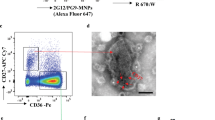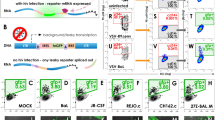Abstract
The development of an HIV vaccine will require a more precise understanding of the immunological and virological underpinnings of HIV infection. Magnetofection, the process of magnetizing HIV by coupling it to ferrous nanoparticles and coordinating infection using a magnetic field, synchronizes the viral replication cycle at attachment while recapitulating the events of natural infection. Although spinoculation also concentrates virus onto target cells to increase infection, it does not synchronize infection. The synchronization of HIV infection in vitro facilitates the study of events in the viral replication cycle and the antiviral immune response on timelines previously impossible. Furthermore, by infecting a high percentage of cells in a short time frame, magnetofection increases the throughput of in vitro assays. Once a virus stock is generated, magnetofection of target cells is rapid, requiring only 1–2 h. Here we present a detailed protocol for this assay and review its applications for studying the immune response to HIV.
This is a preview of subscription content, access via your institution
Access options
Subscribe to this journal
Receive 12 print issues and online access
$259.00 per year
only $21.58 per issue
Buy this article
- Purchase on Springer Link
- Instant access to full article PDF
Prices may be subject to local taxes which are calculated during checkout




Similar content being viewed by others
References
Mykhaylyk, O., Antequera, Y.S., Vlaskou, D. & Plank, C. Generation of magnetic nonviral gene transfer agents and magnetofection in vitro . Nat. Protoc. 2, 2391–2411 (2007).
Buerli, T. et al. Efficient transfection of DNA or shRNA vectors into neurons using magnetofection. Nat. Protoc. 2, 3090–3101 (2007).
Migueles, S.A. et al. Lytic granule loading of CD8(+) T cells is required for HIV-infected cell elimination associated with immune control. Immunity 29, 1009–1021 (2008).
Sacha, J.B. et al. Gag-specific CD8+ T lymphocytes recognize infected cells before AIDS-virus integration and viral protein expression. J. Immunol. 178, 2746–2754 (2007).
Sacha, J.B. et al. Pol-specific CD8+ T cells recognize simian immunodeficiency virus-infected cells prior to Nef-mediated major histocompatibility complex class I downregulation. J. Virol. 81, 11703–11712 (2007).
Sacha, J.B. et al. Gag- and Nef-specific CD4+ T cells recognize and inhibit SIV replication in infected macrophages early after infection. Proc. Natl. Acad. Sci. USA 106, 9791–9796 (2009).
Sacha, J.B. et al. Differential antigen presentation kinetics of CD8+ T-cell epitopes derived from the same viral protein. J. Virol. 82, 9293–9298 (2008).
Minang, J.T. et al. Efficient inhibition of SIV replication in rhesus CD4+ T-cell clones by autologous immortalized SIV-specific CD8+ T-cell clones. Virology 372, 430–441 (2008).
Minang, J.T. et al. The Mamu B 17-restricted SIV Nef IW9 to TW9 mutation abrogates correct epitope processing and presentation without loss of replicative fitness. Virology 375, 307–314 (2008).
Minang, J.T. et al. Nef-mediated MHC class I down-regulation unmasks clonal differences in virus suppression by SIV-specific CD8(+) T cells independent of IFN-gamma and CD107a responses. Virology 391, 130–139 (2009).
Thomas, J.A., Ott, D.E. & Gorelick, R.J. Efficiency of human immunodeficiency virus type 1 postentry infection processes: evidence against disproportionate numbers of defective virions. J. Virol. 81, 4367–4370 (2007).
Haim, H. et al. Soluble CD4 and CD4-mimetic compounds inhibit HIV-1 infection by induction of a short-lived activated state. PLoS Pathog. 5, e1000360 (2009).
Haim, H., Steiner, I. & Panet, A. Time frames for neutralization during the human immunodeficiency virus type 1 entry phase, as monitored in synchronously infected cell cultures. J. Virol. 81, 3525–3534 (2007).
Haim, H., Steiner, I. & Panet, A. Synchronized infection of cell cultures by magnetically controlled virus. J. Virol. 79, 622–625 (2005).
Maness, N.J. et al. AIDS virus specific CD8+ T lymphocytes against an immunodominant cryptic epitope select for viral escape. J. Exp. Med. 204, 2505–2512 (2007).
O'Doherty, U., Swiggard, W.J. & Malim, M.H. Human immunodeficiency virus type 1 spinoculation enhances infection through virus binding. J. Virol. 74, 10074–10080 (2000).
van't Wout, A.B., Schuitemaker, H. & Kootstra, N.A. Isolation and propagation of HIV-1 on peripheral blood mononuclear cells. Nat. Protoc. 3, 363–370 (2008).
Loffredo, J.T. et al. The antiviral efficacy of simian immunodeficiency virus-specific CD8+ T cells is unrelated to epitope specificity and is abrogated by viral escape. J. Virol. 81, 2624–2634 (2007).
Acknowledgements
This work was supported by NIH grants RO1 AI076114 and R01 AI049120 to D.I.W. We thank M. Buechler and L. Newman for technical assistance and A. Espinosa for administrative support.
Author information
Authors and Affiliations
Contributions
J.B.S. and D.I.W. designed the experiments, analyzed data and wrote the manuscript. J.B.S. carried out the experiments.
Corresponding author
Rights and permissions
About this article
Cite this article
Sacha, J., Watkins, D. Synchronous infection of SIV and HIV in vitro for virology, immunology and vaccine-related studies. Nat Protoc 5, 239–246 (2010). https://doi.org/10.1038/nprot.2009.227
Published:
Issue Date:
DOI: https://doi.org/10.1038/nprot.2009.227
This article is cited by
-
Dynamic nanopore long-read sequencing analysis of HIV-1 splicing events during the early steps of infection
Retrovirology (2020)
-
Multiparametric characterization of rare HIV-infected cells using an RNA-flow FISH technique
Nature Protocols (2017)
-
Pseudotyped murine leukemia virus for schistosome transgenesis: approaches, methods and perspectives
Transgenic Research (2014)
-
Immune clearance of highly pathogenic SIV infection
Nature (2013)
-
Magnetic Nanoparticles Enhance Adenovirus Transduction In Vitro and In Vivo
Pharmaceutical Research (2012)
Comments
By submitting a comment you agree to abide by our Terms and Community Guidelines. If you find something abusive or that does not comply with our terms or guidelines please flag it as inappropriate.



